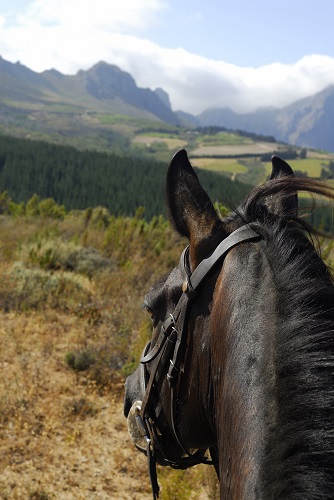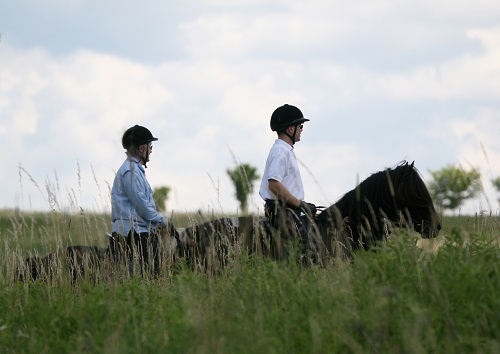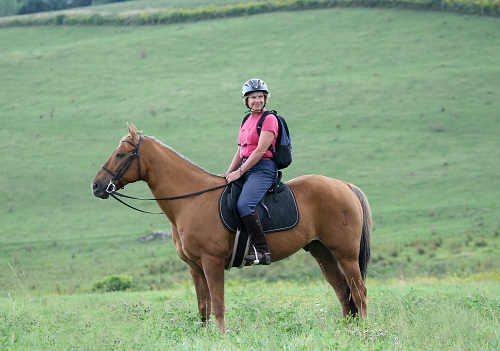How many of us dreamed as a kid about secret pirate maps and finding buried treasure? Well, dreamers unite! Now you can live out this childhood fantasy in real life. And for horsepeople, it’s even better, because the treasure hunt takes place on horseback.

Treasure Trekking
Treasure hunting in this day and age is called geocaching, and it’s a worldwide phenomenon. According to the sport’s official website, Geocaching.com, founded in 2000, there are more than two million caches set up around the globe and more than five million geocachers — both those who hide and those who seek.
Here’s how it works: Individuals and groups have set up treasure troves in all manner of sizes and places, then posted their caches’ locations on Geocaching.com using Global Positioning System coordinates. Interested treasure hunters then use handheld GPS units to follow the coordinates to the cache.
Geocaching was originally designed for hikers. Equestrians have found that equicaching (geocaching on horseback) is a natural extension of geocaching, especially since many cache-rich hiking trails are multiuse trails that allow horseback riding. Equicaching can also be part of a group trail ride or horse-camping trip.
Tech Meets Trail
Equicaching sounds easy, right? Kind of a high-tech hide-and-seek. Well, it’s a bit more challenging than it sounds, since GPS technology only gets you within the range of the cache. You still have to find the cache, which is hidden.
The easy part is that you can explore the wide world of equicaching with just the basics: a trail-savvy horse; a way to trailer your horse to the trails near the cache (if needed); and a handheld GPS unit or a geocaching application on your smartphone or pad.
GPS units cost between $100 and $1,000, depending on how fancy you want the functionality to be. Well-known brands include DeLorme, Garmin, Magellan, and Rand McNally. You can also rent a unit. (Go to www.tek4travel.com.)
The Geocaching.com app for an Android or Apple mobile device is about $30 per year; or you can sign up for a three-month membership for $10.
What’s in a Cache?
Caches can range in size from a tiny metal cylinder hidden underneath a rock to a recycled high school metal locker camouflaged inside a dead tree trunk.

Caches usually include some type of log for you to record your find. The log may be anything from a notebook to a small tightly rolled slip of paper, depending on the size of the cache container. Some caches hold only the log; these are marked “Log Only” on Geocaching.com. Some cache containers may also hold surprises that have been left for you to enjoy, such as homemade items, little plastic or rubber knickknacks, or even gift certificates.
As an equicacher, you can leave something equine in nature, such as a horseshoe-nail ring, a small horse-oriented token, or a bit of braided mane hair tied with a ribbon.
When you’ve finished celebrating your find and signing the log book, close the cache container tightly to keep out the weather, and replace the cache exactly as you found it. Then log your find on Geocaching.com.
Consider hiding a separate cache for a seeker to find. (For how to hide a cache container, go to www.geocaching.com/play/hide.)
Equicaching Etiquette
Geocaching has been around long enough that it has developed its own rules of etiquette. Here are a few rules that also apply to equicaching:
- If you take something, leave something of equal or greater value. Most items should be placed in zip-close plastic bags.
- Never leave a perishable item in the cache container.
- Replace the container just as you found it so the next explorer has the same chance you had to find it.
- If you can’t find a cache, no matter how hard you search, log that information on Geocaching.com, as well. It’ll indicate to the cache owner that it’s time to make sure the cache hasn’t disappeared or been vandalized.
- Clean up the area around the cache.
- Regular folks who don’t geocache or equicache are called “muggles.” Be careful if they’re around while you’re searching — you don’t want them to undo the magic of equicaching!
Know Before You Go
As in any trail-riding adventure, there are safety protocols to keep in mind as you prepare to head out on your first equicaching escapade. Here are a few you need to know.

* Never go equicaching alone. This type of adventure is always more fun with friends. What if you get to the cache location, but you need to climb a rock or go bushwhacking through the underbrush to find the cache? Having another pair of hands to hold the horses on the trail while you explore is the best way to optimize the experience. Then, after discovering the treasure, you can return to the trail and let your riding buddy explore.
* Consider the weather. Satellite signals can be affected by inclement weather. This means your GPS unit may not be completely accurate. Be aware of this as you head out for your adventure, and maybe consider a backup option if your GPS unit isn’t working when you get to the trail.
* Plan your route in advance. GPS measures distances as the crow flies, not as the horse trots. A cache that’s supposedly 500 yards ahead may require you to go a much greater distance by the trail to reach it. Research the trail in advance, and even print out maps, so you’ll know where to park your rig.
* Mark the trail. As you head down the trail, use some method to mark your way (such as three rocks). This will help you find your way back after the excitement of the treasure hunt has worn off, and you, your riding buddies, and your equine friends are ready to head home.
Now, load up your trusty trail horse, saddle up, and go make those childhood treasure-hunting fantasies come true! Discover equicaching!
Jenny Sullivan is a seasoned equine journalist and Quarter Horse owner who enjoys trail riding near her home in Colorado.
GPS Resource Guide
Following are four manufacturers of handheld GPS units suitable for equicaching, plus selection tips.
DeLorme (A Garmin Brand)
Look at the Topo USA and the PN-40 models.
Garmin Ltd.
Check out the eTrex or Oregon models.
Magellan
Explore the eXplorist models, built specifically for geocaching.
Rand McNally
Click on the Foris model, the latest device from the most trusted name in maps.
Save




